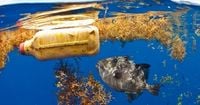Every day, the world’s oceans are inundated with the equivalent of 2,000 full garbage trucks of plastic waste. From candy wrappers to grocery bags and even balloons, the relentless tide of debris is more than just an eyesore—it’s a deadly hazard to marine life. A groundbreaking new study, published in Proceedings of the National Academy of Sciences on November 20, 2025, has revealed just how little plastic it takes to kill seabirds, sea turtles, and marine mammals. The findings are as sobering as they are urgent, highlighting the existential threat plastic pollution poses to ocean wildlife and underscoring the need for immediate global action.
To get to the bottom of this crisis, scientists analyzed autopsy data from more than 10,000 deceased marine animals, drawing from 53 studies conducted around the globe. According to BBC, the research team included experts from the US-based environmental group Ocean Conservancy. Their analysis focused on three main groups: seabirds, sea turtles, and marine mammals such as seals, sea lions, dolphins, and whales. The results were nothing short of alarming.
Seabirds, for instance, face extreme risk after ingesting just 23 pieces of plastic, which gives them a 90% chance of dying. "For seabirds, ingesting just six tiny pieces of rubber, each smaller than about the size of a pea, can result in a 90 percent chance of death," said Britta Baechler, a co-author of the study and director of Ocean Plastics Research at the Ocean Conservancy, as reported by NPR. The danger isn’t limited to birds. Marine mammals reach similar peril after swallowing only 29 pieces of plastic, and for sea turtles, the threshold is around 405 pieces to reach the same 90% risk of mortality. It’s shocking to think that less than a soccer ball’s worth of soft plastic can be fatal to a dolphin, or that an Atlantic puffin could die from ingesting less than three sugar cubes’ worth of plastic.
But what exactly are these animals eating? The study, as detailed by BBC and NPR, found that the type of plastic matters. For seabirds, rubber is the most dangerous culprit—just a handful of tiny pieces can spell disaster. Marine mammals are most threatened by soft plastics and fishing debris, while both hard and soft plastics pose risks to sea turtles. The researchers focused their efforts on macroplastics—debris visible to the naked eye—so their findings don’t even account for the potential damage caused by microplastics or the effects of entanglement, both of which are known to be harmful as well.
To put a face on this tragedy, the scientists recounted some of the more harrowing autopsy findings. Among the victims, as NPR reported, was an albatross with an entire plastic bottle lodged in its digestive tract. In another case, a sperm whale died after swallowing a three-gallon bucket that shattered inside its gut, causing a fatal obstruction. These are not isolated incidents. Nearly half of the sea turtles studied, a third of the seabirds, and one in ten of the marine mammals had plastic in their stomachs. Hundreds of marine species have now been documented with plastic inside their bodies, a grim testament to the scale of the crisis.
So why do these animals keep eating plastic? The answer is heartbreakingly simple: plastic often looks—and sometimes even feels or sounds—like food. As Greg Merrill, a researcher specializing in plastics and marine animals (who was not involved in the study), explained to NPR, animals like sea turtles can easily mistake floating plastic bags for jellyfish, one of their favorite snacks. "Like if you are a sea turtle, for example, and you eat jellyfish, a plastic grocery bag is pretty similar. It’s fluid. It’s not got a lot going on with it," Merrill said. Whales, which hunt in the pitch-black depths of the ocean using sonar, can be tricked by the acoustic signature of plastic waste, which mimics the echo of their natural prey. Merrill added, "So it kind of suggested that perhaps they’re mistaking their acoustic cues and ingesting plastic that way."
What’s perhaps most troubling is that the study only scratches the surface of the problem. It didn’t examine the impacts of microplastics—tiny fragments that have now been found even in the deepest parts of the ocean—nor did it assess the effects of chemical contamination or entanglement in discarded fishing gear and other debris. This means the true scale of harm is likely even greater than the numbers suggest.
The conclusions drawn by the researchers are stark. "It’s a really important reminder that plastic pollution does pose an existential threat to ocean wildlife," said Dr. Erin Murphy, the study’s lead researcher and a member of Ocean Conservancy, as quoted by BBC. The message from the scientific community is clear: urgent action is needed to stem the tide of plastic entering the oceans.
What can be done? The researchers, along with outside experts like Merrill, argue that policy changes are needed at the international level to reduce the production of plastic products, especially single-use plastics such as soda bottles and food packaging. These items are designed to be used once but can persist in the environment for decades, if not centuries. "To effectively address plastic pollution, the science is clear. We need to reduce the amount of plastic we produce, improve collection and recycling, and clean up what’s already out there," Dr. Murphy emphasized.
Britta Baechler echoed this sentiment, telling NPR, "I think it’s pretty obvious but plastic pollution is not just unsightly. It really does represent a serious immediate threat to marine life and we need urgent action." The study’s authors hope that by quantifying the lethal thresholds for plastic ingestion, they can provide policymakers and the public with the data needed to drive meaningful change.
There’s no denying the scale of the challenge. Every day, more plastic enters the ocean, compounding a crisis that is already devastating marine ecosystems. But the science is now clearer than ever: it doesn’t take much plastic to kill. Even a handful can be fatal. With the evidence mounting and the stakes rising, the world faces a stark choice—act now to curb plastic pollution, or risk losing some of the ocean’s most iconic and vulnerable creatures forever.





